Sun, Surf and Deer: Island Whitetails
Whitetails Unlimited 09.08.11
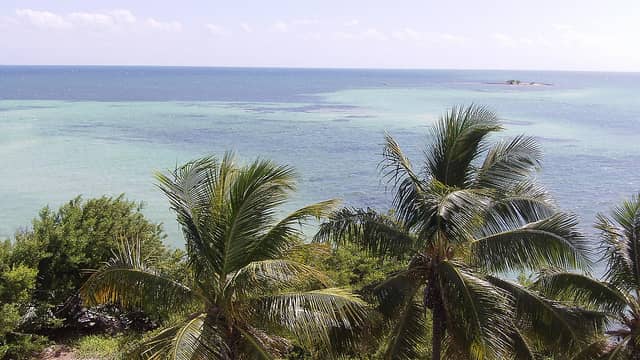
Just another typical day in the Florida Keys – sun, palm trees, lobsters, dolphins, a magnificent sunset and deer. That’s right, white-tailed deer, gliding silently out of the tree line at dusk, gathering in twos and threes to munch on tender grasses in open fields.
The Keys have a unique atmosphere where very little seems typical, and these are not the typical whitetails most hunters think of. Odocoileus Virginianus Clavium is the official name of the Florida Key Deer, a subspecies of the white-tailed deer. The physically smallest subspecies of North American deer, Key deer were nearly extinct in the 1940s. Now, although still listed as an endangered species, the Key deer have a stable population thanks to habitat preservation, protection and the establishment of a Federal Refuge.
Observed in a field from a distance Key deer look like any other deer. But up close, or when they move next to an object of known size, their most dramatic characteristic is obvious. They’re small. Compared to Midwestern whitetails they’re tiny. Mature does weigh 45 to 65 pounds, and full-grown bucks range from 55 to 75 pounds. The shoulder height is 24 to 30 inches. At birth fawns weigh 2 to 4 pounds, about half the size of a “standard” whitetail.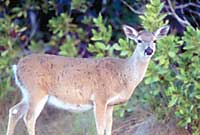
The face is slightly wider and they have shorter noses, both traits that add to the juvenile appearance of the adults. “The adults still look like fawns, sort of like a toy deer,” said one observer.
The vast majority of Key deer are located on two islands: Big Pine Key and No Name Key, about 90 miles from the Florida mainland and 30 miles from Key West, which is where the Coastal Highway ends. While still endangered, the population of Key deer is now estimated to be 400 to 600 animals, and may be reaching the carrying capacity of the two islands.
Active swimmers, they can travel to other islands, and small numbers of individuals currently range from Johnson Key to Saddlebunch Key, but are found nowhere else in the world outside of the Keys. Early records indicate wide distribution throughout the Keys, with the earliest reference found in the writings of a shipwrecked Spaniard named Fontaneda, who was held captive by local Indians in the 1550s. Hundreds of years ago island residents as well as the crews of ships used the small deer as food.
The deer have adapted to island life and their small size is a reaction to the unique environment. They can tolerate brackish water for short periods of time, but fresh water is necessary for their survival. Many of the islands in the Keys do not have reliable supplies of natural fresh water, which limits their range.
Key deer feed on native plants such as thatch palm berries and red, black and white mangroves, in addition to more than 160 other species of plants. As the islands were gradually developed for permanent human residence additional plants and ornamental grasses and shrubs were introduced, providing additional feeding opportunities for the deer, often to the consternation of the more recent human residents.
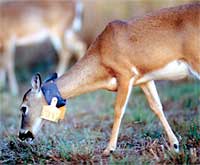 The climate in the Keys is fairly constant, with temperatures from 70 to 90 degrees Fahrenheit year-round. Breeding early enough to insure the young can survive a cold winter is not a problem for the Key deer. However, their reproductive cycle is similar to that of their Northern cousins. Rutting activities typically begin in early September, peaking in early October and decreasing gradually through November and December. Some breeding can occur as late as February. The gestation period averages 204 days (compared to an average of 200 days for the more common whitetail species) and most fawns are born in April and May. Males drop their rack during February and March, and regrowth of the rack begins almost immediately, so that stubs are visible in June. Antler growth is complete in August and velvet is rubbed off by mid-September.
The climate in the Keys is fairly constant, with temperatures from 70 to 90 degrees Fahrenheit year-round. Breeding early enough to insure the young can survive a cold winter is not a problem for the Key deer. However, their reproductive cycle is similar to that of their Northern cousins. Rutting activities typically begin in early September, peaking in early October and decreasing gradually through November and December. Some breeding can occur as late as February. The gestation period averages 204 days (compared to an average of 200 days for the more common whitetail species) and most fawns are born in April and May. Males drop their rack during February and March, and regrowth of the rack begins almost immediately, so that stubs are visible in June. Antler growth is complete in August and velvet is rubbed off by mid-September.
Radio-tagging research indicates that females live longer than males, averaging 6.5 years, compared to just under 3 years for males. Does have been known to live for 19 years, and bucks have been known to live up to 12 years. The deer that live farther away from Highway 1, the main highway linking the Keys, live longer than deer that live closer to the highway. Other studies indicate that males cover twice as much territory per day than does, which means that they likely cross roadways more frequently, contributing to their higher death rates.
The state of Florida banned hunting of Key deer in 1939, but earlier unregulated hunting, and later poaching, hurricanes, droughts and habitat destruction drove the Key deer to the edge of extinction, with one source claiming only 27 individuals remained at the time the National Key Deer Refuge was established in 1957. The Key deer was listed as an endangered species in 1967, where it still remains. Today, the automobile is the greatest threat to Key deer, accounting for 50 to 70% of the annual deaths. People who illegally feed the deer alter their natural behavior and cause them to forage along roadsides, increasing the likelihood of additional accidents. All feeding of wild Key deer is illegal.
The National Key Deer Refuge is on Big Pine Key and includes more than 8,500 acres, 2,278 of which are designated wilderness area. The headquarters and informative visitor center is in the Big Pine Key Plaza off Key Deer Boulevard. The refuge includes some of the historical range of the Key deer and is also home to the imperiled tropical hardwood hammock habitat and 22 additional federally listed endangered and threatened species of plants and animals, five of which are found nowhere else in the world. The refuge is easily accessible, with more than 90,000 people visiting each year, hiking on trails and observing a wide variety of wildlife in addition to the Key deer.
Key deer are not limited to the refuge area and it is common to see them in yards, along roads and occasionally in the town of Big Pine. An early morning stroll along a back road is commonly interrupted by deer crossing the road, and the underbrush along roadsides on the island is dotted with trails entering the vegetation. Deer are most active during early morning and late afternoon, and are less active during the heat of midday. When observing the Key deer along roads it is advised to remain fully within your vehicle. If on foot, do not approach them, extend your arms towards them or attempt to call them toward you. Do NOT feed them. These are wild animals, not pets, and the more they associate people with food the more likely they are to die or be injured by a car. Some individuals will approach people or cars, but as soon as they realize they won’t get a handout they move along. Federal law prohibits feeding or disturbing any Key deer, or any other wildlife within the Refuge.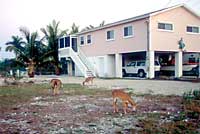
Even though the Key deer are small, their diminished size is not an indication of frailty. Like other whitetails these deer are incredibly tough and adaptable. One deer observed along a roadside had a severely dislocated shoulder, probably from a collision with a car weeks or months before. This deer could easily forage, move through the underbrush and keep up with other deer when darting from perceived danger.
When hurricane Georges assaulted the Keys in 1998 winds of more than 100 mph tore at the Key deer territory and the storm surge completely submerged much of the habitat and contaminated the fresh water supply with ocean water. Texas A&M University had radio collars on 53 deer at that time and recorded only one fatality, a drowning. Some areas known to contain deer were completely submerged, and yet both adults and fawns survived.
Key deer are fascinating to watch, and fairly easy to find as they come out to feed near sunrise and sunset. While you need to travel to, almost literally, the end of the road to see them, they fit in well in the laid-back atmosphere of the Florida Keys. If you’re ever one of those four million visitors to the Keys, take a break from the sun, sand and surf and spend some time with the world’s smallest white-tailed deer.
A note about the Keys:
The Florida Keys (from the Spanish cayos, meaning small islands) are a chain of islands that extend southwest some 150 miles from the Southeastern tip of Florida. During the last ice age the Keys were a continuous strip of land connected to what is now Florida, but melting glaciers caused ocean levels to rise, isolating individual islands. The native deer have been isolated on these islands for 4,000 to 10,000 years, and have developed a distinct subspecies in response to the unique conditions on the islands.
The Keys have been used by humans for thousands of years. Native Tequestas and Caloosa Indians lived in the Keys when Ponce de Leon claimed the islands for Spain in the early 1500s. Spain gave up their colony to the United States in 1821. In 1912 a railroad line was opened connecting Key West with the mainland, followed by a 120-mile highway in 1938 allowing individual car access.
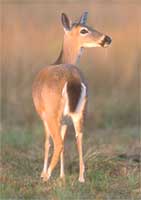 Hundreds of individual islands make up the Keys, some of them just points of land sticking a couple of feet out of the ocean with a topping of vegetation. Key West, one of the larger and most developed islands, is less than 10 square miles. The only natural source of fresh water on most islands is what pools on the ground from rainfall, and the highest elevation in the Keys is an ear-popping 16 feet above sea level (average elevation is 10 feet).
Hundreds of individual islands make up the Keys, some of them just points of land sticking a couple of feet out of the ocean with a topping of vegetation. Key West, one of the larger and most developed islands, is less than 10 square miles. The only natural source of fresh water on most islands is what pools on the ground from rainfall, and the highest elevation in the Keys is an ear-popping 16 feet above sea level (average elevation is 10 feet).
Pirates, privateers, salvers and traders have use the Keys for hundreds of years, and contemporary accounts make reference to Key deer being used as an occasional food source for sailors. While the total population of Key deer has never been large, after the Overseas Highway was completed, allowing hunters and developers access to the Keys in large numbers, the Key deer population dropped quickly.
Today in the Keys some 80,000 human residents live on just over 30 of the islands. An estimated four million visitors travel to the islands each year, and tourism is by far the biggest industry in the Keys, with Key deer being one of the attractions. While still endangered, the population of Key deer is now estimated to be 400 to 600 animals, and may be reaching the carrying capacity of the two islands where the vast majority of Key deer live, Big Pine Key and No Name Key.
Many areas in the country have discovered that protecting wildlife has a beneficial effect on the tourism industry, as well as being good conservation policy. Managing natural resources in the Florida Keys is challenging and wide-ranging, from underwater nature preserves to an endangered deer subspecies, all of which are of interest to visitors.
By Jeff Davis, Whitetails Unlimited
Photo: Sean McMenemy

